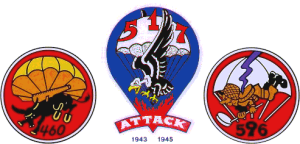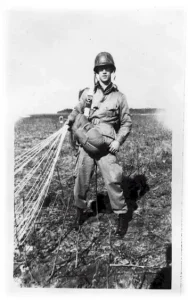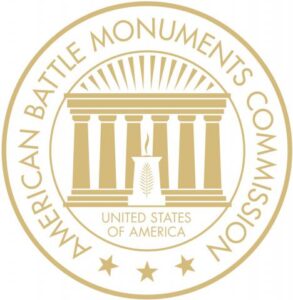
Why would anyone jump out of a perfectly good airplane? Here are several reasons according to some of the paratroopers of the 517th:
“I was leaning towards the airborne. I’m sure I wasn’t the dumbest one there but I had no idea what that would mean. The first appeal was a vague notion we would not have to do much walking. Later I realized that the parachute was only a means of transportation … there was plenty of walking to do on each end of the airborne trip. [1]”

“I owned a small crystal radio set. I listened to the actual speeches of Hitler at three and four in the morning. I was appalled at the crazy delivery, the anger, and the delight of the audience. After Pearl Harbor, my desire to get into the war led me to ask for assignment to the parachute troops. [2]”
“When asking for volunteers to be paratroopers, I asked ’Is it snowing in Georgia?’ When told no, that did it for me. I got off the train in Georgia wearing a heavy woolen overcoat while a hot sun was shining. [3]”
Whether the reasons were humorous or serious, eventual paratroopers often cite other reasons for volunteering, such as testing themselves or for excitement [4]. It was out of these attitudes that paratroop units were born.
The 517th Parachute Infantry Regiment was formed at Camp Toccoa, Georgia in March 1943 as part of the 17th Airborne Division. After their three infantry battalions were augmented with the 460th Parachute Field Artillery Battalion and the 596th Parachute Combat Engineer Company, they became the 517th Parachute Regimental Combat Team and the largest of the independent parachute units.
The 517th actually did not jump into its baptism of fire. In fact, the unit saw its first combat action in Italy a few months before Operation Dragoon. In June 1944, just days after the Normandy landings, the 517th found itself attached to the veteran 36th Infantry Division. Their mission was to push the Germans out of Italy. If the Germans were pressured in Italy, then they could not reinforce German troops in Normandy or on the Eastern Front [5]. It was during this time that the brothers of the 517th would become aware of their mortality. They lost their first fellow paratrooper, Sgt. Andrew Murphy.
“Blood was spurting five or six feet in the air,” stated Pvt. Melvin Biddle, who would later receive the Medal of Honor for his actions at the Battle of the Bulge. “It’s an awful thing to see nice people killed right in front of you. Two hours before, he’d shared a package from home, including me who’d just joined the company, and now he was dead. [6]”

The initial shock was difficult, and the paratroopers would spend less than two weeks in combat in Italy, but not without lessons learned.
“The enemy resistance was not real strong but we recognized in a hurry their artillery capability,” said Lt. Col. Dick Seitz. “More importantly, we learned that we were pretty damn good. The men and their leaders became cocky, convinced they could achieve in combat.[7]”
After Italy, the 517th received the opportunity to do what they were trained to do: take the fight to the enemy after exiting an aircraft. Operation Dragoon was devised in order to pressure and push the Germans out of Southern France and free up vital ports in the south. The 1st Airborne Task Force was created and included the 517th, which at this time numbered 3,900 paratroopers [8]. This was the largest that the unit would ever be.
The invasion started on Aug. 15, 1944. The 517th had responsibilities of taking the towns of Le Muy and La Motte in order to control access to the Rhone River Valley and prevent German reinforcements. Many found themselves scattered to the wind, sometimes as far as 30 or more miles off of their objectives, but the paratroopers were not deterred. On Aug. 16, 1944, after facing stiff resistance, the town of Le Muy was taken by the 517th, along with the 191st Tank Battalion and the 45th Infantry Division. West of Le Muy in the town of Les Arcs, the Germans re organized and the 517th started to see the first signs of a German response. By the end of the day, however, the Battling Buzzards and other Allied elements had surrounded Les Arcs [9].
Spirits were high but casualties were mounting. It would only get worse. On Dec. 16, 1944, Hitler launched Germany’s last offensive through the Ardennes Forest. The fighting and the elements were harsh. The 517th joined in and would stick together but would be attached and re-attached to various units (whether airborne or not). They would also find themselves engaged in the equally as harsh Battle of the Hurtgen Forest, and the number of original Toccoa troops dwindled. Both combat and non-combat casualties, especially frostbite, were high and took their toll on the unit. The unit would eventually suffer a casualty rate of over 80 percent of its assigned strength.
Despite its short existence, the 517th left a lasting mark on U.S. military history. The 517th had fought in five campaigns in France, Belgium, Italy, and Germany, and 1,500 Purple Hearts later, produced eight generals, including two who had started their military careers as privates [10]. James Gavin, who became the 82nd Airborne Division’s commander during World War II, stated: “We had an idea. We wanted to tell these guys that they were the most capable guys on earth. And any parachute squad is worth a platoon of anybody else.[11]” Like other airborne units, the 517th carried this attitude. Being an independent parachute unit and after being attached and re-attached to other units so many times, their esprit-de-corps only grew, so it must have been with great sadness to the remaining Buzzards that in February 1946, at Fort Bragg, North Carolina, their unit was quietly dissolved. The unit was never reactivated.

[1] Gerald Astor, Battling Buzzards: The Odyssey of the 517th Parachute Regimental Combat Team 1943-1945 (Dell Publishing (Random House) New York, New York, 1993), 67-68. Interview with John Warren Chism.
[2] Astor, Battling Buzzards: The Odyssey of the 517th Parachute Regimental Combat Team 1943-1945, 69. Interview with Paul Smith.
[3] Astor, Battling Buzzards: The Odyssey of the 517th Parachute Regimental Combat Team 1943-1945, 70. Interview with Russel Brami.
[4] Astor, Battling Buzzards: The Odyssey of the 517th Parachute Regimental Combat Team 1943-1945, 399.
[5] Astor, Battling Buzzards: The Odyssey of the 517th Parachute Regimental Combat Team 1943-1945, 117.
[6] Astor, Battling Buzzards: The Odyssey of the 517th Parachute Regimental Combat Team 1943-1945, 127.
[7] Astor, Battling Buzzards: The Odyssey of the 517th Parachute Regimental Combat Team 1943-1945, 139.
[8] William B. Breuer, Operation Dragoon: The Allied Invasion of Southern France (Presidio Press, California, 1987), 140.
[9] Jeffrey J. Clarke and Robert Ross Smith, Riviera to the Rhine: The European Theater of Operations (University Press of the Pacific, Honolulu, Hawaii, 2005), 118-119.
[10] Astor, Battling Buzzards: The Odyssey of the 517th Parachute Regimental Combat Team 1943-1945, 2.
[11] Astor, Battling Buzzards: The Odyssey of the 517th Parachute Regimental Combat Team 1943-1945, 3.
 An official website of the United States government. Here's how you know.
An official website of the United States government. Here's how you know. 